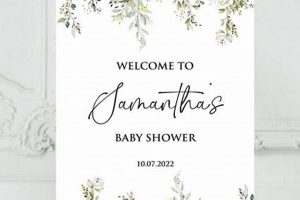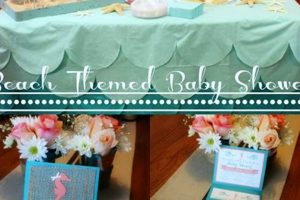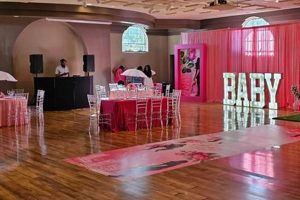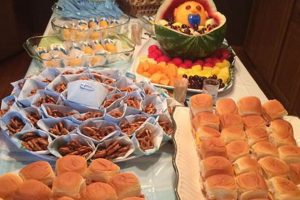A baby shower activity where guests personalize plain infant bodysuits with fabric markers, paint, stencils, or other embellishments. This interactive event provides expecting parents with a collection of unique clothing items for their baby, while also offering guests a creative and memorable experience. For example, attendees might draw animals, write inspirational quotes, or apply iron-on transfers to the onesies.
The practice offers multiple advantages. It furnishes the parents-to-be with personalized, handmade items, fostering a sense of community and support. It serves as an engaging and entertaining activity for shower guests, moving beyond traditional games. Furthermore, it creates lasting mementos of the celebration that the child can wear and the parents can cherish. The concept leverages the human desire to create and gift something personal to celebrate a new life.
The subsequent sections will delve into the materials required for a successful implementation of this activity, provide guidance on setting up the workspace, and offer creative ideas to inspire participants. Considerations for safety and managing a large group will also be addressed.
Tips for a Successful Onesie Decorating Activity
Executing a onesie decorating activity at a baby shower requires careful planning to ensure a smooth and enjoyable experience for all participants. The following tips offer guidance on key aspects of preparation and execution.
Tip 1: Material Selection is Crucial: Opt for high-quality, pre-washed, 100% cotton onesies in various sizes (0-3 months, 3-6 months, 6-9 months) to accommodate the baby’s growth. Pre-washing minimizes shrinkage after decoration.
Tip 2: Provide a Diverse Range of Decoration Supplies: Gather an assortment of fabric markers (various colors and tip sizes), fabric paint, stencils, iron-on transfers, stamps, and embellishments like buttons or ribbons. Ensure all supplies are non-toxic and safe for use on infant clothing.
Tip 3: Workspace Setup is Essential: Designate a spacious and well-lit area with individual workstations for each guest. Cover surfaces with protective coverings (e.g., tablecloths, newspapers) to prevent stains. Provide cardboard inserts to place inside the onesies to prevent paint bleeding.
Tip 4: Offer Design Inspiration: Display examples of decorated onesies or provide idea sheets with various themes and designs. This can help spark creativity and provide guidance for guests who may feel unsure where to start.
Tip 5: Set Clear Time Limits: Allocate a specific timeframe for the decorating activity (e.g., 45 minutes to 1 hour) to ensure the shower schedule remains on track. Announce the time remaining periodically.
Tip 6: Safety First: Emphasize the importance of using non-toxic materials and following safety guidelines for all supplies. Supervise the use of heat-activated tools (e.g., iron for transfers) to prevent accidents.
Tip 7: Facilitate Cleanup: Provide readily available cleaning supplies (e.g., wet wipes, paper towels) for guests to clean up spills and messes. Designate a disposal area for used materials.
Implementing these tips will enhance the overall experience, ensuring a well-organized, creative, and enjoyable onesie decorating activity.
The subsequent sections will address common challenges encountered during the activity and offer strategies for addressing them proactively.
1. Onesie Material
The selection of appropriate bodysuit fabric directly impacts the success and longevity of decorated garments within the context of a baby shower activity centered on embellishing these items. The fiber content, weave, and pre-treatment of the cloth determine how well it accepts and retains various decorating mediums, such as fabric markers, paint, and iron-on transfers. Inadequate material choice can lead to bleeding of colors, cracking of paint after washing, or poor adhesion of embellishments, ultimately diminishing the value of the finished product. For instance, a polyester blend might repel water-based fabric paints, resulting in a faded or uneven design. Conversely, a tightly woven cotton material provides a stable and absorbent surface, promoting vibrant and durable artwork.
The practical implications of material selection extend beyond aesthetic considerations. Infants possess sensitive skin, and coarse or chemically treated fabrics can cause irritation or allergic reactions. Opting for 100% pre-washed cotton minimizes the risk of such issues and ensures the comfort of the garment. Furthermore, the weight of the fabric affects its suitability for different climates. Lightweight cotton is ideal for warm weather, while thicker fabrics provide greater insulation in colder environments. Considering these factors enables the creation of personalized baby clothing that is both visually appealing and functionally appropriate.
In summary, the choice of fabric represents a critical component of planning a “decorate a onesie baby shower.” Its impact extends from the ease of decoration and the visual quality of the finished product to the comfort and safety of the infant wearing the garment. Selecting a high-quality, natural fiber like pre-washed cotton is paramount for a successful and meaningful outcome. Overlooking this factor can lead to frustration and wasted effort.
2. Decoration Variety
In the context of a baby shower centered on customizing infant bodysuits, the breadth of available decorating materials directly influences the engagement, creativity, and ultimate success of the activity. A limited selection can stifle artistic expression, while a diverse array fosters innovation and allows guests to create truly unique and personalized items. This section will explore key facets of the types of decorations offered.
- Fabric Markers and Pens
These writing implements allow for detailed linework and precise application of color. Fine-tip markers are suitable for intricate designs and lettering, while broader markers can quickly fill larger areas. The use of permanent, non-toxic fabric markers ensures washability and prevents fading or bleeding. For example, guests might use these to draw cartoon characters, write the baby’s name, or create geometric patterns. The availability of a range of colors expands the possibilities for creative expression.
- Fabric Paints and Stencils
Fabric paints provide a medium for applying bold colors and creating textured effects. Stencils offer a structured approach to design, allowing guests to easily create repeating patterns or recognizable shapes. Sponges, brushes, and other applicators can be used to achieve various effects. Examples include painting animal silhouettes, floral motifs, or abstract designs using stencils. The consistency and washability of the fabric paint are critical factors to consider.
- Iron-On Transfers and Appliqus
Pre-designed or custom-made iron-on transfers provide a convenient way to add complex images or text to the onesies. Appliqus, such as felt shapes or embroidered patches, can be sewn or adhered to the fabric to create three-dimensional effects. The ease of application and durability of these embellishments are important considerations. Guests might use iron-on transfers to add popular cartoon characters, sports team logos, or personalized messages. Appliqus can add texture and visual interest to simple designs.
- Embellishments and Accessories
A variety of embellishments, such as buttons, ribbons, lace, and beads, can be used to add unique details and textures to the decorated onesies. These accessories allow for customization beyond simple painting or drawing. Proper adhesives or sewing techniques are necessary to ensure that the embellishments remain securely attached after washing. Examples include adding ribbon bows, sewing on small buttons to create eyes for animal characters, or attaching lace trim to the edges of the onesies.
The overall impact of “Decoration Variety” within the context of a “decorate a onesie baby shower” extends beyond simply providing options. A well-curated selection of materials empowers guests to express their creativity, resulting in a collection of unique and personalized garments that hold sentimental value for the expecting parents. The availability of diverse options also caters to different skill levels and artistic preferences, ensuring that all guests can participate and contribute to the celebration.
3. Workspace Design
The arrangement and functionality of the physical area dedicated to decorating infant bodysuits within the context of a baby shower significantly impacts participant engagement, creativity, and the overall success of the activity. A poorly designed workspace can hinder the flow of activity, limit access to materials, and ultimately detract from the intended celebratory atmosphere.
- Surface Protection and Cleanliness
The immediate work surfaces must be covered with protective materials such as disposable tablecloths, craft paper, or plastic sheeting. This prevents permanent staining from fabric paints, markers, and adhesives, safeguarding the venue’s furnishings. Furthermore, easy access to cleaning supplies, including wet wipes and paper towels, is essential for managing spills and maintaining a tidy environment. For example, a spill of fabric paint without adequate protection can result in costly damage and significant disruption to the event.
- Individual Workstations
Providing designated workstations for each participant, with adequate spacing between them, is crucial for preventing crowding and ensuring comfortable movement. Each station should include a sturdy surface, ample lighting, and easy access to essential tools and materials. For instance, a cramped workspace with inadequate lighting can lead to frustration, reduced attention to detail, and a lower quality of finished product.
- Material Accessibility and Organization
The strategic placement and organization of decorating supplies, such as fabric markers, paints, stencils, and embellishments, directly affects the efficiency and creativity of the participants. Materials should be readily accessible, clearly labeled, and arranged in a logical manner to minimize delays and facilitate the design process. An example of effective organization is the use of tiered trays or open containers to display markers and paints, allowing guests to quickly select the desired colors.
- Ventilation and Safety Considerations
Adequate ventilation is essential, particularly when using fabric paints or adhesives with strong odors. A well-ventilated space minimizes discomfort and potential health risks associated with prolonged exposure to fumes. Additionally, safety measures, such as providing cutting mats and scissors with blunt tips, are necessary to prevent accidents and ensure a safe working environment. Inadequate ventilation and a lack of safety precautions can lead to headaches, dizziness, and potential injuries, negatively impacting the overall experience.
The interconnectedness of these facets illustrates the importance of comprehensive planning when designing a workspace for a “decorate a onesie baby shower” activity. By prioritizing cleanliness, organization, accessibility, and safety, the event host can create an environment that fosters creativity, promotes engagement, and ensures a positive and memorable experience for all participants. Failure to address these elements can result in a chaotic and unproductive activity, diminishing the enjoyment of the celebration.
4. Time Allocation
Effective management of time is paramount to the successful integration of a decorating station into a baby shower. The duration allocated to this activity influences guest participation, the complexity of designs, and the overall flow of the event. Insufficient time may lead to rushed creations and incomplete projects, while excessive time can result in boredom or disruption of other planned activities.
- Activity Duration vs. Shower Schedule
The time allotted for onesie decoration must align with the broader shower schedule, considering the total event length and other planned activities, such as games, gift opening, and socializing. A poorly integrated activity, either too long or too short, can disrupt the pace of the event and negatively impact guest enjoyment. As an example, allocating two hours to onesie decorating at a two-hour shower leaves insufficient time for other traditional elements.
- Skill Level and Design Complexity
The designated timeframe must consider the range of artistic abilities among guests and the anticipated complexity of designs. Simple designs employing fabric markers require less time than intricate patterns using stencils, paint, and embellishments. Providing design templates or offering assistance can help guests complete their projects within the allotted time. For instance, if most guests lack artistic experience, restricting the activity to marker-based designs and pre-cut stencils can ensure timely completion.
- Material Availability and Accessibility
Efficient use of the allocated time is contingent upon the accessibility and organization of decorating materials. Insufficient materials or a poorly organized workspace can lead to delays and frustration, reducing the time available for actual decorating. Ensuring adequate supplies and a well-structured workspace minimizes downtime and maximizes creative output. A scenario where only a limited number of stencils are available would result in guests waiting for extended periods, hindering their ability to participate effectively.
- Guest Participation and Engagement
The allotted time influences the level of guest participation and engagement. A clearly defined timeframe with periodic progress updates encourages guests to remain focused and productive. Providing a visual timer or announcing time remaining can help maintain momentum and ensure that most guests complete their projects. Conversely, an open-ended timeframe may lead to procrastination or disengagement, with some guests dominating the activity while others lose interest.
Integrating these facets of time allocation into the planning of a “decorate a onesie baby shower” activity is crucial. Careful consideration of the shower schedule, guest skill levels, material availability, and participation dynamics enables the creation of a well-paced and enjoyable experience. Prioritizing time management ensures that the activity complements the overall celebration, resulting in personalized keepsakes and positive memories for the expecting parents and their guests.
5. Safety Protocols
Implementing stringent safety protocols at a baby shower where guests are decorating infant bodysuits is not merely a formality, but a critical necessity. The use of potentially hazardous materials, coupled with the presence of expectant mothers and other adults, warrants a comprehensive approach to risk mitigation. Failure to prioritize safety can result in injuries, allergic reactions, or exposure to toxic substances.
- Material Toxicity
The selection of non-toxic and hypoallergenic materials is paramount. Fabric markers, paints, adhesives, and embellishments must be specifically formulated for use on infant clothing and certified to be free of harmful chemicals such as lead, phthalates, and formaldehyde. Verification of these certifications through manufacturer documentation is essential. For example, using untested or imported materials may expose infants to hazardous substances that can cause skin irritation, respiratory problems, or long-term health issues.
- Ventilation and Respiratory Protection
Adequate ventilation is required, especially when using spray adhesives, fabric paints, or other materials that release volatile organic compounds (VOCs). A well-ventilated space minimizes the concentration of airborne contaminants and reduces the risk of respiratory irritation or sensitization. In confined spaces, the use of respirators or masks certified for VOC protection may be necessary, particularly for individuals with pre-existing respiratory conditions. Neglecting proper ventilation can lead to headaches, dizziness, and, in severe cases, long-term respiratory damage.
- Safe Handling of Tools and Equipment
The use of sharp objects, such as scissors, craft knives, and hot glue guns, necessitates strict safety protocols. Scissors should have blunt tips, and craft knives should be used only under supervision, with appropriate cutting mats. Hot glue guns should be equipped with safety stands and used with caution to prevent burns. A designated first-aid kit should be readily available to treat minor injuries. Lack of supervision or improper use of these tools can result in cuts, burns, and other injuries requiring medical attention.
- Allergy Awareness and Prevention
Prior to the event, it is crucial to inquire about any known allergies among the guests. This information allows for the selection of hypoallergenic materials and the implementation of precautionary measures to minimize the risk of allergic reactions. For example, latex gloves should be avoided if any guests have a latex allergy. Clear labeling of materials and the provision of alternative options can help prevent accidental exposure to allergens. Failure to accommodate allergies can lead to skin rashes, respiratory distress, and, in extreme cases, anaphylaxis.
These interconnected safety protocols are not merely suggestions, but essential components of planning a “decorate a onesie baby shower.” By diligently addressing potential hazards and implementing preventative measures, the host can create a safe and enjoyable environment for all participants, ensuring that the focus remains on celebrating the upcoming arrival of the child.
Frequently Asked Questions
The following addresses common inquiries regarding the planning and execution of a baby shower activity centered on personalizing infant bodysuits.
Question 1: What are the essential materials required for a onesie decorating station?
Key components include plain, pre-washed 100% cotton onesies in various sizes; non-toxic fabric markers and paints; stencils; iron-on transfers; embellishments such as buttons or ribbons; protective table coverings; cardboard inserts to prevent paint bleeding; and cleaning supplies.
Question 2: How can the safety of participants, particularly expectant mothers, be ensured?
Select only non-toxic and hypoallergenic materials. Ensure adequate ventilation in the workspace. Provide blunt-tipped scissors and cutting mats. Inquire about guest allergies beforehand. Supervise the use of heat-activated tools.
Question 3: What is the optimal timeframe to allocate for this activity during a baby shower?
The allotted time depends on the overall shower schedule, the complexity of the designs, and the skill level of the guests. Typically, 45 minutes to 1 hour is sufficient.
Question 4: How can artistic creativity be encouraged among guests who may not consider themselves creative?
Provide design inspiration through example onesies, idea sheets, or pre-made stencils. Offer assistance and guidance throughout the activity. Emphasize that the goal is to create a personalized keepsake, not a perfect artwork.
Question 5: What are some strategies for managing a large group of participants effectively?
Designate a spacious workspace with individual workstations. Organize materials for easy access. Assign a helper to assist with setup, cleanup, and answering questions. Divide guests into smaller groups if necessary.
Question 6: How can the decorated onesies be properly cared for to ensure longevity of the designs?
Follow the washing instructions provided on the fabric paint or marker packaging. In general, washing the onesies inside-out on a gentle cycle and air-drying is recommended. Avoid harsh detergents or bleach.
In summary, successful execution necessitates prioritizing safety, planning sufficient time, offering design guidance, and organizing the workspace effectively. Doing so will maximize guest involvement and produce mementos which are both practical and sentimental.
The following will discuss innovative themes that can elevate the “decorate a onesie baby shower” experience to memorable levels.
Conclusion
The practice of hosting a “decorate a onesie baby shower” presents a multifaceted opportunity. It allows for the creation of personalized gifts for the expectant parents, serves as an interactive activity for guests, and fosters a sense of community around the impending arrival of a new child. Successful implementation relies on careful attention to material selection, workspace design, time management, and adherence to safety protocols.
By addressing these critical components, event organizers can ensure an engaging and memorable experience for all involved. The resulting collection of customized infant bodysuits represents a tangible expression of support and affection, providing a lasting reminder of the celebration and the anticipation surrounding the birth. This activity is more than entertainment; it is a contribution to the foundational elements of early parenthood.


![Personalized Custom Baby Shower Sign - [Theme] & More! Baby Care 101: Essential Tips for Happy, Healthy Babies Personalized Custom Baby Shower Sign - [Theme] & More! | Baby Care 101: Essential Tips for Happy, Healthy Babies](https://singlebabies.com/wp-content/uploads/2025/12/th-932-300x200.jpg)




